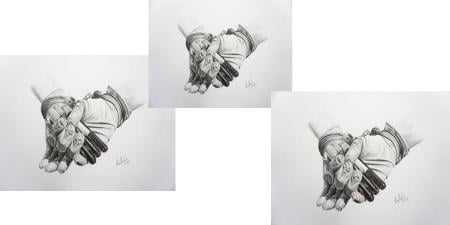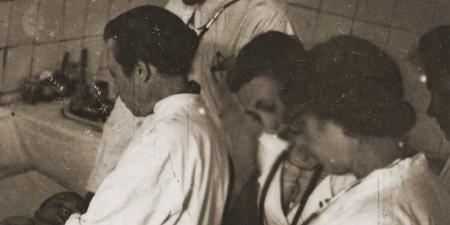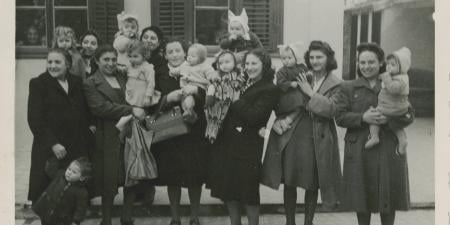Abstract
The legacy of health professionals’ roles in the Holocaust is fundamental to understanding modern health care ethics, but teaching it is difficult. The University of Colorado Center for Bioethics and Humanities has developed a program that addresses 4 main pedagogical challenges of this content. This article identifies 3 core lessons and proposes 5 specific learning objectives related to health professionals’ involvement in the Holocaust for any health professional training program.
Introduction
The legacy of health professional involvement in the Holocaust is fundamental to understanding modern health care ethics, but specific teaching about this history is required in only 22 (16%) of medical schools in the United States and Canada.1 This history is relevant today, as health professionals address disabilities, disparities, racism, and discrimination in carrying out their professional obligations to serve all individuals with respect and dignity, to use science responsibly, to maintain necessary professional distance while preserving compassion and intimacy, and to prevent conflicts of interest from compromising practice. At the University of Colorado Anschutz Medical Campus, despite general support from students and faculty, we have faced significant challenges in remembering, transmitting, and applying lessons of the Holocaust. This article describes these challenges and our responses to them.
Challenges
The Holocaust was not executed by a few proverbial bad apples or rogue clinicians but by professions synchronizing execution of state-organized crimes against humanity in the name of science and public health. Helping health professions students comprehend this history requires overcoming 4 obstacles:
- Complex, voluminous content. One could easily spend a career studying health professional dimensions of Holocaust history. Adding this material deftly to health sciences curricula requires that educators have sufficient content knowledge and carefully select educational objectives.
- Teaching genocide is demanding for faculty. The Holocaust was medically driven genocide, arguably the sentinel event in modern health care ethics. Few faculty members are comfortable with teaching or pedagogically prepared to teach this content skillfully.
- Learning about atrocities is demanding for students. Because Nazi doctors are frequently regarded as monstrous and evil, identifying similarities between Nazi clinicians and clinicians today is not intuitive for most students. Relating past atrocities to contemporary practical health care ethics problems can provoke confusion and defensiveness in students that can interfere with their reflection. What’s more, the reality that more than 50% of German physicians voluntarily joined the Nazi party2 and that their atrocities were executed under the banner of science and public health3 is not easy for many students to accept.
- Competition for curricular time. While ethics and professionalism must be included in medical education curricula, content about ethical and social implications of clinicians’ roles in the Holocaust is not required. In fact, history teaching has dwindled to nonexistence in most programs.4
Model Program
The University of Colorado Anschutz Medical Campus’s program, Holocaust Genocide and Contemporary Bioethics (HGCB), promotes “education, scholarship and community engagement on the lessons of the Holocaust for health care and society.”5 With a coordinated, annual cycle of activities, including a student writing contest and multiple campus and community educational opportunities, the program delivers an annual International Day of Remembrance lecture for first-year health professions students. During the National Week of Remembrance for Victims of the Holocaust, nationally recognized keynote speakers participate in several days of activities, such as lectures, panel discussions, community events, art gallery exhibits, and musical performances across multiple University of Colorado campuses. Broad participation in the HGCB program is aided by stewardship of its advisory group, which includes partner organization members, academicians, community members, students, clinicians, and staff.
The Holocaust was not executed by a few proverbial bad apples or rogue clinicians.
An evening discussion group meets regularly to consider essential lessons of the Holocaust, how to teach them, and how they relate to contemporary bioethics, particularly basic human rights protections. In the United States, other relevant historical examples include clinician participation in slavery,6 researchers intentionally infecting Guatemalans with sexually transmitted diseases in the 1940s,7coerced sterilization of Native American8 and Latina9 women in the 1970s, the US Public Health Service Syphilis Study at Tuskegee,10 and torture practices at Guantanamo Bay and other military detention camps.11 Recent discussions were convened about public and patient trust in medicine, duties to protect vulnerable patients and communities, what constitutes the proper role of science in society, humanistic health care, and how to manage competing professional interests. The workgroup recently recommended 3 core lessons and 5 specific learning objectives for integrating this content into health professions ethics curricula.12
Since the Holocaust, in particular, demonstrates how health professionals’ failure to balance competing tensions negatively affected professions, patients, and society, each of the 3 lessons considers approaches to persistent sources of tension faced routinely by today’s clinicians.
- Commitment to science. One approach to balancing reason and skepticism in searches for scientific truth is aided by cultivating awareness of when ideology could motivate unproven theories or override well-proven science, such as when Nazi physicians drove eugenic ideas in the 1940s and ignored non-Aryan scientists’ work or when today’s clinicians ignore climate science or endorse antivaccination.
- Clinical detachment. Health professionals must be able to form deep, enduring human connections with patients and maintain their ability to work while resisting inurement to suffering and death, even as individual patients suffer and die.
- Competing loyalties. Health professionals must uphold their commitments to society and to individual patients while also navigating personal and professional commitments to employers, family, colleagues, the state, and others.
Health professions students’ learning of these 3 lessons can be cultivated by adopting the following 5 objectives. By graduation, each student in the HGCB program should be able to:
- Describe the theory of eugenics and its relationship to racism.
- Describe at least 3 social, economic, or other factors that prompted many German health professionals in the1930s to prioritize state interests over individuals’ interests.
- Describe at least one US-based forced sterilization program and its temporal and ideological relationships to Nazi programs.
- Describe the Nazi child “euthanasia” and T4 programs and how they related to later programs of mass murder in the Holocaust.
- Describe at least 2 rationales used by German physicians to justify experimentation on prisoners.
These 3 lessons and 5 objectives motivate students’ learning of the facts of the Holocaust relevant to health professionalism today; help health professions schools meet standards for curricular content on cross-cultural awareness, health inequity, and ethics; and promote students’ development of Accreditation Council for Graduate Medical Education core competencies related to patient care and professionalism.
Augmenting Existing Curricula
These 3 lessons and 5 objectives can also be integrated into existing health professions curricular materials by exploring eponymous terms, such as Asperger’s syndrome,13 and their relation to Nazi science and discussing eugenics during genetic science lessons and when presenting content on disability, health equity, clinician bias, and racism. Integrating this content can help model humanistic caregiving practices and underscore the fundamental roles of ethics in promoting good patient outcomes and professional well-being. Each generation of health professionals must earn their patients’ trust and execute their unique responsibilities as leaders, scientists, and healers, despite conflicting loyalties. Students need to learn about genocide’s medicalization during the Holocaust, which is key to strengthening their impulses to protect human rights and hold sacred their relationships with patients.
References
-
Wynia MK, Silvers WS, Lazarus JA. How do US and Canadian medical schools teach about the role of physicians in the Holocaust? Acad Med. 2015;90(6):699-700.
-
Haque OS, De Freitas J, Viani I, Niederschulte B, Bursztajn HJ. Why did so many German doctors join the Nazi Party early? Int J Law Psychiatry. 2012;35(5-6):473-479.
-
Weindling P. Health, Race, and German Politics: Between National Unification and Nazism, 1870-1945. Cambridge University Press; 1989.
-
Kollmer Horton ME. The orphan child: humanities in modern medical education. Philos Ethics Humanit Med. 2019;14(1):1.
-
Center for Bioethics and Humanities, University of Colorado Anschutz Medical Campus. Holocaust Genocide and Contemporary Bioethics Program. Accessed May 20, 2020. https://www.cuanschutz.edu/centers/bioethicshumanities/education/holocaust-genocide-and-contemporary-bioethics-program
- Owens DC, Fett SM. Black maternal and infant health: historical legacies of slavery. Am J Public Health. 2019;109(10):1342-1345.
- Spector-Bagdady K, Lombardo PA. From in vivo to in vitro: how the Guatemala STD experiments transformed bodies into biospecimens. Milbank Q. 2018;96(2):244-271.
- Lawrence J. The Indian Health Service and the sterilization of Native American women. Am Indian Q. 2000;24(3):400-419.
- Novak NL, Lira N, O’Connor KE, Harlow SD, Kardia SLR, Stern AM. Disproportionate sterilization of Latinos under California’s eugenic sterilization program, 1920-1945. Am J Public Health. 2018;108(5):611-613.
-
Jones JH. Bad Blood: The Tuskegee Syphilis Experiment. Free Press; 1993.
-
Physicians for Human Rights. Experiments in torture: evidence of human subject research and experimentation in the “enhanced” interrogation program. June 2010. Accessed August 7, 2020. https://docisolation.prod.fire.glass/?guid=844afd5c-83aa-4aa3-cbed-0de2a24e6c08
-
Levine MA, Wynia MK, Himber M, Silvers WS. Pertinent today: what contemporary lessons should be taught by studying physician participation in the Holocaust? Conatus J Philos. 2019;4(2):283-298.
-
Sheffer E. Asperger’s Children: The Origins of Autism in Nazi Vienna. WW Norton & Co; 2018.



